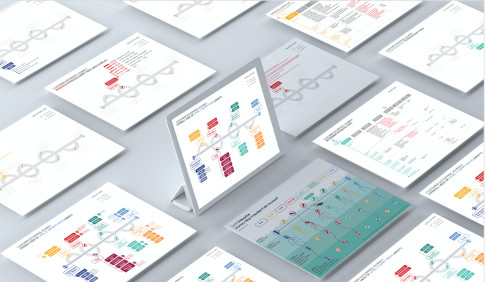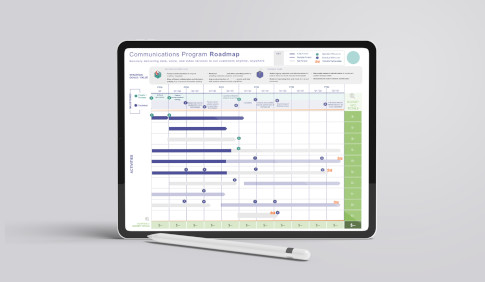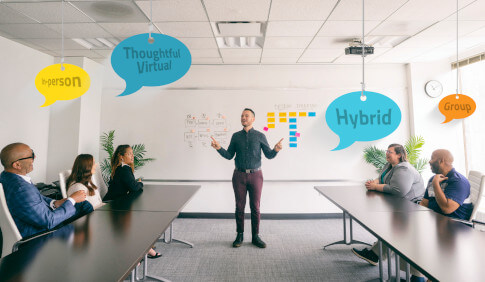Thinking Beyond Logistics: Tips for Designing and Executing Impactful Events
Think back to the last time you hosted or attended an event. Was there a packed agenda with no hope of staying on schedule? What about a lackluster networking event where everyone grabbed a free drink and headed straight home? Did you experience cost overruns on catering and AV? 84% of leaders believe in-person events are a critical component of their company’s success. As event hosts, we could be doing more to ensure the attendee experience is intentionally designed to maximize their experience.
Organizations, including associations, have an incredible opportunity to convert attendees into advocates and ambassadors when they plan beyond logistics. Event planners are masters at reducing vendor costs, but they do little in terms of planning an outcome-driven experience. At The Clearing, we specialize in designing outcome-driven events that will leave participants feeling inspired, engaged, and committed to making progress at the conclusion. Here are four things to keep in mind next time your organization is planning an event.
START WITH THE END IN MIND
When planning an event, it’s critical to know the WHY. Starting with the end in mind is important when designing intentional outcome-driven events not only for your internal project team but also for the attendee experience.
With the WHY in mind, ask your team these guiding questions:
What shifts in mindset and/or behavior is your organization hoping to inspire attendees to make by the end of the event?
Where are your attendees starting FROM today? Consider internal factors and environmental factors such as demographic, sociocultural, political/legal, technological, economic, and global impacts.
Where do we see attendees getting TO by the end of the event?
Taking the time upfront to think about the FROM-TO shifts, or keeping the WHY in mind, will make designing the rest of the attendee experience an easier process.
NOT ANOTHER PANEL DISCUSSION…
When designing the program, be creative with the use of people, time, and space. According to the American Society for Training & Development, the retention rate for experiential knowledge is 75%, significantly higher than lecture at 5% or group discussion at 30%. Consider experiential options that get attendees out of their seats or actively contributing to the content beyond the default panel discussion.
CAMPFIRE SESSIONS
Campfire sessions are a great way to blend traditional plenary sessions with enhanced audience participation. A Campfire Session begins with 15-20 minutes of planned content from a presenter, who then shifts into a facilitator role as the rest of the session becomes an audience-driven discussion.
SOLUTION ROOMS
A Solution Room is designed to provide peer advice on attendees’ most pressing problems. Attendees are given time to think of a challenge they are facing within their organization. The group votes on which problems they would like to help address. Once the problem set is established, attendees are divided into small groups. Each attendee takes turns presenting their problem while the group helps to brainstorm possible solutions. All of this is done in time-boxed, rapid succession, with the intent of covering a lot of content in a short amount of time.
Delivering content in unique and innovative, even disruptive, ways will increase the chance attendees will remember the discussion. It will also increase the likelihood they will attend your next event.
PROVIDE GUIDANCE FOR SPEAKERS
Most events have themes and general messages. Event planners identify speakers and ask them to create content but rarely are speakers informed beyond the basics. Ensure your event remains consistent and on message by providing prep time for all speakers, especially panelists. Take a moment to provide keywords, phrases, and talking points to assure the speakers understand the key messages of the event and the experience you’re trying to create for your attendees. Set clear expectations with your speakers and panelists regarding what you expect them to cover and how you’d like the narrative to sound. A little coaching and management will go a long way to ensuring both speakers and attendees experience a worthwhile session that delivers the intended outcomes.
DON’T LEAVE NETWORKING TO CHANCE
One of the top five reasons individuals attend events is to network and meet people. Don’t leave networking and relationship building to chance. Find creative ways to facilitate conversations and ensure attendees walk away with new connections.
When designing networking opportunities it’s important to consider different personality types. Finding fun and engaging ways for attendees to make meaningful connections doesn’t have to revolve around a table. Lawn games such as cornhole can be a fun and unique way for individuals to meet in a more informal setting. If there is a welcome event prior to the start of the main attraction, consider finding a way to build in connection points.
Creating an opportunity for individuals to connect before the main event will produce friendly faces. People will have a cohort to meet up with during breaks and trade notes and remain connected to each other for the entirety of the event.
Putting on a great event is so much more than logistics, it’s about the attendee experience from start to finish. A well-executed event has the capability to re-energize your members and save you money. Don’t rely on your logistics team to design in the mindset of your audience. At The Clearing, we specialize in designing engaging meetings and events that achieve specific outcomes to build value for your attendees. Interested in learning more about what we can do for your upcoming event? Send me an email to start a conversation today.
—
Nicholas Srebrow is a Director at The Clearing and co-lead for the firm’s group focused on the commercial sector clients. Nicholas leads a team of consultants focused on delivering best-in-class organizational change management services.
Avoid Becoming Accidental Adversaries While Building Stronger Coalitions
Coalition (n): a temporary alliance of distinct parties, persons, or states for joint action.
Climate change, substance abuse, terrorism, these global issues affect all of us regardless of demographics or posture in life. Such complex issues unite and polarize, create and destroy. No issue, big or small, will be solved by one person or one organization acting alone. Reaching a common, complex goal requires tremendous planning and coming together of diverse parties to take sustained, coordinated action.
ACCIDENTAL ADVERSARIES
When an issue feels large or insurmountable, it is easy to get discouraged and even hostile toward those around you, even if you are working towards the same goal. The term Accidental Adversaries describes what happens when two or more parties working together fall out of alignment. Problems arise when one or both parties are not satisfied with current progress or approach and take corrective measures that unintentionally obstruct the success of the other party.
When this occurs, parties start to look at each other as competitors instead of allies despite their original intention of working together. Adversarial behavior manifests in a few ways. You may notice individuals getting weighed down by the minutiae or becoming overly consumed with taking credit for positive results while being quick to place blame on others.
Accidental adversaries are common and create unnecessary roadblocks. Don’t let accidental adversaries hinder your forward progress. At The Clearing, we specialize in helping parties come together to tackle some of the world’s most complex problems. Utilizing POWER Prime, here are three conversations you can prompt in order to build stronger coalitions as you chase solutions to the issues around you. The PRIMES© are documented in the book, The PRIMES: How Any Group Can Solve Any Problem, (John Wiley & Sons, Inc., copyright © 2012) authored by Chris McGoff, founder of The Clearing.
THREE CONVERSATIONS YOU CAN HAVE TO BUILD STRONGER COALITIONS
Shared Perspective
Work through the clutter to get a clear picture of the problem. Individuals often think their personal perspective is the right one and parties find themselves lost in a sea of information and fragmented direction because they don’t have a shared, agreed-upon perspective of the problem they face. A shared perspective turns a problem into an opportunity.
Shared Intent
Align everyone around a common vision. Once everyone has a common understanding of the problem, all parties must be aligned on the direction and desired outcome. Establish a shared intent by discussing what is at STAKE if the issue isn’t resolved to ensure everyone understands the urgency for action.
Coordinated Action
Focus resources on the fewest, most important initiatives to achieve the desired outcome. Oftentimes large plans can seem overwhelming and impossible to implement. Build trust through incremental short term success with the REDPOINT framework. After achieving several quick wins, the momentum grows, and transformation becomes possible.
It takes many people coming together powerfully to cause sustainable solutions. Let’s dent the universe and tackle complex issues together. Email me and let me know how I can help you and your organization create forward progress today.
—
Nicholas Srebrow is a Director at The Clearing and co-lead for the firm’s group focused on the commercial sector clients. Nicholas leads a team of consultants focused on delivering best-in-class organizational change management services.

 The Clearing’s Employee Experience
Improvement model, adapted from Itam
& Ghosh, 2020, focuses on three
objectives: Engagement, Enablement,
and Autonomy.
The Clearing’s Employee Experience
Improvement model, adapted from Itam
& Ghosh, 2020, focuses on three
objectives: Engagement, Enablement,
and Autonomy.











